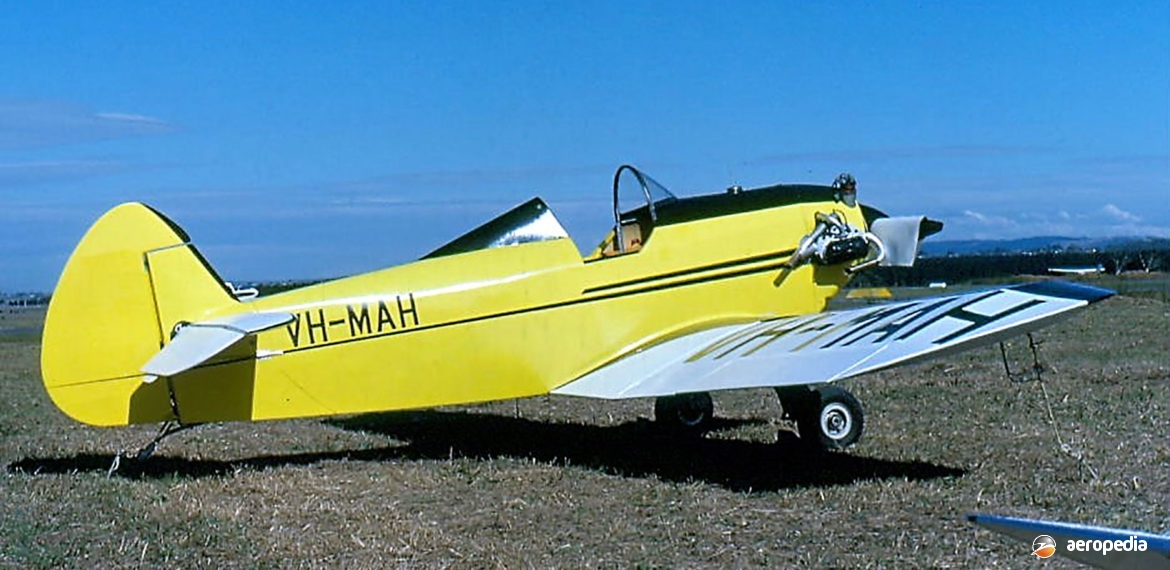Photograph:
Taylor JT-1 Monoplane VH-MAH (c/n V33) at Morwell, VIC in April 1980 (David C Eyre)
Country of origin:
United Kingdom
Description:
Single-seat light sport monoplane
Power Plant:
One 34 kw (45 hp) modified Volkswagen four-cylinder horizontally-opposed air-cooled engine
Specifications:
- Wingspan: 6.4 m (21 ft)
- Length: 4.57 m (15 ft)
- Height: 1.47 m (4 ft 10 in)
- Wing area: 7.06 m² (76 sq ft)
- Max speed at sea level: 169 km/h (104 mph)
- Cruising speed: 148 km/h (92 mph)
- Stalling speed: 69 km/h (43 mph)
- Max rate of climb at sea level: 198 m/min (650 ft/min)
- Range: 370 km (230 miles)
- Empty weight: 186 kg (410 lb)
- Loaded weight: 276 kg (610 lb)
History:
The Taylor JT-1 monoplane was designed in the United Kingdom in the 1950s by the late John Taylor. He built the prototype with the object of producing an airframe for not more than £100 Sterling. Construction took about 14 months and the prototype (G-APRT) was flown for the first time on 4 July 1959. In 1964 the JAP engine was replaced by a 1500 cc Rollason Ardem engine, a conversion of a Volkswagen four-cylinder unit.
Of all-wood structure, with plywood covering, except for elevators and rudder, which were fabric covered, the JT-1 could be fitted with a variety of engines. The two most commonly used were the modified Volkswagen, and the 28 kw (38 hp) JAP two-cylinder unit. Other engines fitted have included the 30 kw (40 hp) Aeronca E113, 48 kw (65 hp) Continental A-65, 48 kw (65 hp) Lycoming, and a 54 kw (72 hp) McCulloch two-stroke. Aircraft with the 48 kw (65 hp) engine had a 10 cm (4 in) longer nose and a 25.4 cm (10 in) longer rear fuselage to correct the centre of gravity situation. In Australia the 1700 cc Revmaster was fitted to at least one. Accommodation was provided for a pilot under a transparent perspex canopy, and a small luggage locker was situated aft of the seat.
Plans were supplied throughout the world and examples registered in this region have included: VH-ULC (c/n V25), VH-MAH (c/n V33), VH-PJS (c/n Q1), VH-CKC (c/n W22), VH-JXM (c/n V103), VH-ULJ (c/n V20), and VH-TPQ (c/n N117). Most Australian examples are now registered under AUF / RAA regulations. A further example was imported from the United Kingdom. This aircraft, ex G-BKEU (c/n PFA055-10353), became 19-8118 at Serpentine in Western Australia. VH-CKC was lost when it crashed into the sea near Geraldton, WA on 4 January 1973.
New Zealand aircraft include: ZK-CPC (c/n GT-1), ZK-CTV (c/n AACA/51), ZK-CZH (c/n AACA/78), ZK-DQG (c/n AACA/150), ZK-EKU (c/n AACA/178), ZK-EDZ (c/n AACA/391), ZK-ENR (c/n AACA/146), ZK-CRS (c/n AACA/44), ZK-CVH (c/n AACA/170), ZK-JOE (c/n AACA/72), ZK-ROO (c/n TM406), and ZK-EKU (c/n AACA/178). One was commenced as a Taylor monoplane and the registration ZK-CZV (c/n AACA 85) was reserved for the owner/builder at Inglewood but was never taken up. Some modifications were made and when completed it became ZK-WEB (c/n 01). It was to be known as the Spyder, being registered as the Bernard Webb Spyder Monoplane on 26 August 1997. It has since had a number of owners.

